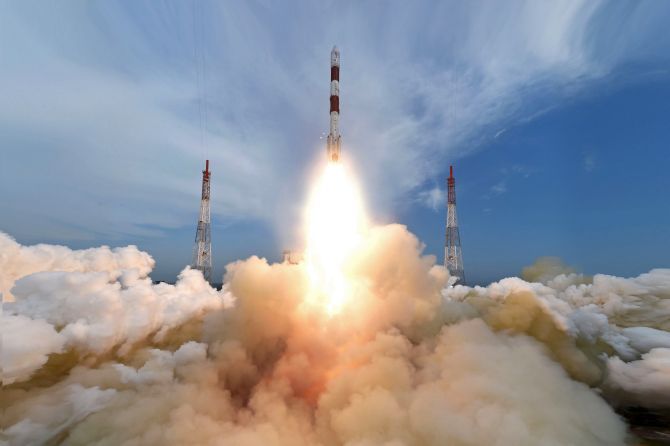
In its longest-ever flight, the PSLV C-35, carrying India’s SCATSAT-1 meant for ocean and weather studies and seven other satellites including from the United States and Canada, on Monday lifted off from the spaceport in Sriharikota.
The launch marked PSLV’s longest mission spread over two hours and it is the first time that the rocket is putting its payloads in two different orbits.
The 44.4 metre tall PSLV rocket blasted off at 9.12 am and 17 minutes later injected SCATSAT-1 in orbit.
“SCATSAT-1 has been successfully injected in orbit,” Indian Space Research Organisation said.
The 371 kg SCATSAT, the primary satellite meant for weather forecasting, cyclone detection and tracking, was first injected in a Polar Sunsynchronous Orbit orbit while the seven others will be injected in a lower orbit after over two hours, the first time the rocket is putting its payloads in two different orbits.
The total weight of all the eight satellites onboard is about 675 kg.
Besides SCATSAT-1, the PSLV rocket is carrying two Indian university satellites, three from Algeria and one each from the US and Canada.
SCATSAT-1 is a “continuity” mission for the Ku-band scatterometre payload carried by SCATSAT-1, which has enhanced features compared to a similar one carried by Oceansat-2 satellite in 2009.
The two academic satellites are PRATHAM, from IIT, Bombay, and PISAT, from BESUniversity, Bengaluru and its consortium. While PRATHAM’s objective is to estimate Total Electron Count, PISAT’s mission is to design and develop a nanosatellite for remote sensing applications.
The foreign satellites onboard the PSLV are ALSAT-1B, ALSAT-2B and ALSAT-1N (all from Algeria) and Pathfinder-1 and NLS-19, from USA and Canada, respectively.
For Monday's longest ever PSLV flight that injected the SCASTSAT-1 and seven other satellites in different orbits, Kumar said adequate trials were conducted for the multi orbit mission, including on restarts.
There were two fourth stage engine restarts for the purpose of injecting the satellites into different orbits.
"So before the actual mission we had the confidence that the systems will work as planned," he said, recalling that ISRO had itself did a near similar feat many years ago.
"In fact we ourselves way back in the C3 mission had done (where) one of the small satellites was pushed upto a slightly higher orbit than the main satellite. But that was a small activity at that time," he said.
ISRO had only "made use of thrusters and not the main engine, then," he said, adding, in today's case, the PS4 engine had been restarted twice.
Photograph: ISRO










